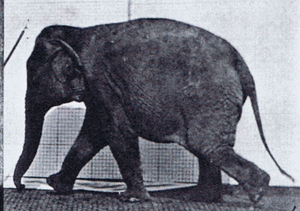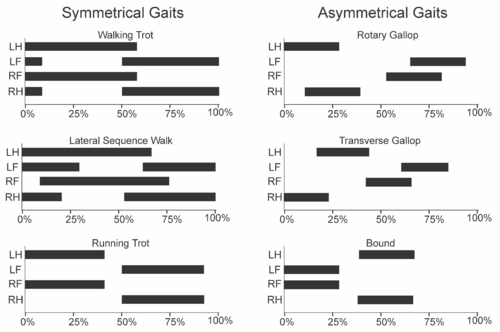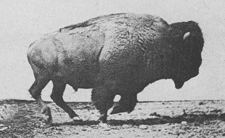Gait facts for kids
A gait is the special way an animal moves its legs when it travels over the ground. Think about how a dog runs or how a person walks! Most animals can use many different gaits. They choose a gait based on how fast they want to go, the type of ground they are on, if they need to turn quickly, and how much energy they want to use. Different animals might use different gaits because their bodies are built differently, or because they have learned the best ways to move in their homes.
It's hard to see exactly how an animal's legs move just by watching. Early scientists tried to figure out gaits from footprints or sounds. But it wasn't until Eadweard Muybridge and Étienne-Jules Marey started taking many fast pictures that we could truly study how animals move.
Contents
Understanding Animal Movement
Scientists like Milton Hildebrand helped us understand and sort out different animal gaits. They looked at each leg's movement in two parts:
- Stance phase: When the foot is on the ground.
- Swing phase: When the foot is lifted and moves forward.
Every leg must finish its movement cycle in the same amount of time. This keeps the animal's movement steady and balanced. So, we can describe any gait by looking at when each leg starts and ends its "stance phase" compared to one main leg.
Types of Gaits: Symmetrical and Asymmetrical
Gaits are often grouped into "symmetrical" and "asymmetrical" types. These names don't mean if the animal's body is balanced left-to-right.
- Symmetrical gaits: In these gaits, the left and right legs of a pair (like the front two legs) take turns moving.
- Asymmetrical gaits: Here, the legs on one side move together. These are sometimes called "leaping gaits" because the animal might have a moment when all its feet are off the ground.
How We Measure Gaits
Two main things help us describe a gait:
- Duty factor: This is the percentage of time a foot stays on the ground during one full movement cycle. If a foot is on the ground for more than half the time (over 50%), it's usually a "walk." If it's on the ground for less than half the time (under 50%), it's a "run."
- Forelimb-hindlimb phase: This describes the timing between the front and back legs on the same side of the animal. For example, if a front leg and a back leg on the same side touch the ground at the exact same time, their phase is 0%. If the front leg touches down half a cycle later, the phase is 50%.
How Gaits Affect Breathing
The way an animal moves can also affect how it breathes!
- Lizards and Salamanders: These animals don't have a special muscle called a diaphragm like humans do. They use the same muscles to move their bodies side-to-side for walking and to push air in and out of their lungs. This means they often can't move and breathe at the same time. Some, like monitor lizards, have found ways around this, like using their throats to pump air.
- Mammals: When a mammal like a horse or a dog gallops, its spine bends and straightens. This movement helps push its internal organs, which then act like a piston to inflate and deflate the lungs. This helps them breathe more air and get more oxygen while running fast.
Different Gaits for Different Animals
Animals usually change their gait as they speed up.
- Most Animals: Almost all animals can use symmetrical gaits.
- Mammals: Asymmetrical gaits, like a gallop, are mostly used by mammals. This is because their flexible spines allow them to stretch out their stride (the distance covered in one step).
- Arboreal Mammals: Animals that live in trees, like monkeys or some opossums, often use a "diagonal sequence walk." This means their front left leg and back right leg move together. This helps them stay stable on branches.
- Sprawling Animals: Animals like salamanders and lizards, whose legs stick out to the sides, often use "diagonal sequence walks" or "trots." Their bodies wiggle from side to side as they move.
- Two-legged Animals (Bipeds): Most animals with two legs, like humans, mainly use three gaits: walking, running, and hopping. Other movements, like skipping, need a special effort.
How Insects Move
Even insects have interesting gaits!
- Flies (Drosophila): Flies often use a "tripod gait." This means three legs swing forward at the same time, while the other three legs stay on the ground for support. At faster speeds, they tend to use this tripod gait more. At slower speeds, they might have four or five legs on the ground.
- Stick Insects: These larger insects show different gaits. As young insects, they might use a tripod gait. But as adults, especially at slow speeds, they often use a "metachronal wave." This is where only one leg lifts and swings forward at a time, moving from back to front on one side, then the other. At higher speeds, they might use a "tetrapod coordination" (two legs swinging together) or still the metachronal wave.
Walking vs. Running: A Mechanical View
Beyond just looking at foot patterns, scientists also classify gaits by how the body moves mechanically.
- Walking: In walking, your body moves like an "inverted pendulum." Imagine swinging over your legs, with your body's center of gravity rising and falling. Your body "vaults" over each leg as it touches the ground.
- Running: When you run, your body acts more like a "spring-mass system." Your muscles, bones, and tendons work like springs, storing and releasing energy with each bounce. This makes your body's energy levels rise and fall together.
Saving Energy with the Right Gait
Animals often choose their gait to save energy.
- Speed and Gait: For animals with four legs, like horses, they usually go from a walk to a trot, then to a gallop as they speed up.
- Optimum Speed: Each gait has a best speed where the animal uses the least amount of energy (calories) to travel a certain distance. If they go slower or faster than this "optimum speed," they use more energy.
- Gait Transitions: Animals switch gaits when the cost of using their current gait becomes higher than the cost of using a different gait. For example, a fast walk might use more energy than a slow run, so the animal switches to running. Wild animals usually move at the most energy-efficient speed for their chosen gait.
Gaits Beyond Four Legs
The ideas of "walking" (inverted pendulum) and "running" (spring-mass model) aren't just for animals with four legs. We see these patterns in animals with two, four, six, or even more legs! Scientists have even used the term "gait" to describe the distinct patterns of movement created by flying and swimming animals in the air or water.
See also
 In Spanish: Andadura para niños
In Spanish: Andadura para niños




